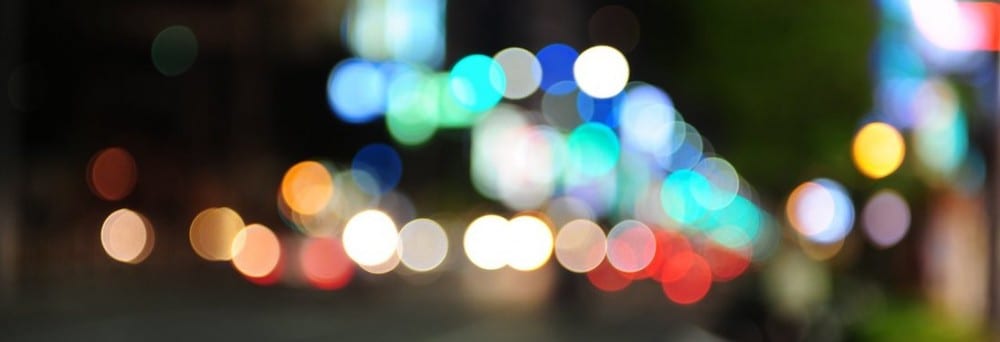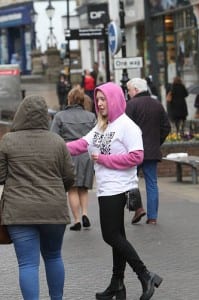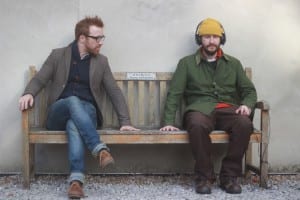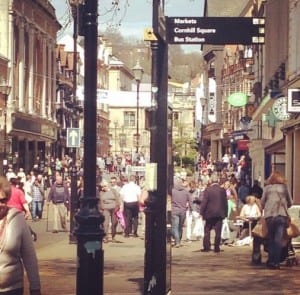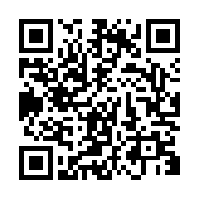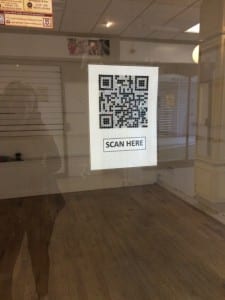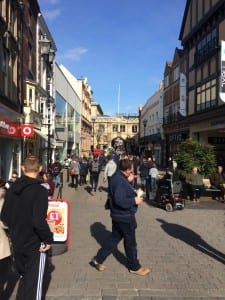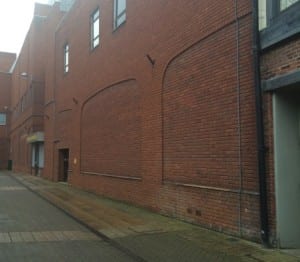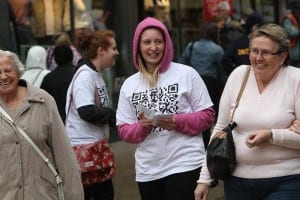Framing Statement:
The site specific performance we were tasked with creating was to be developed and inspired by Lincoln High Street in connection with the Frequency festival 2015, with an exploration of pervasive media and the theme of liberation at the heart of our piece. Our final performance aimed to question the retail space and re-imagine the QR code, a marketing tool commonly used by retailers for advertising, but to offer consumers an altered view of the high street. Our durational piece took place on the 7th May, the day of the general election, and took the form of QR codes, printed on handouts and t-shirts that the audience were invited to interact with by scanning with their smart phones to access the information within. By disrupting the high street in this way and starting a dialogue with the audience we aimed to liberate them from their assumptions of the retail environment and reject the site’s common purpose.
Pervasive media is new types of digital media linked to an awareness of place and location. It is delivered in to the fabric of everyday life. (Watershed, 2015)
Janne Tapper’s article Pervasive Games explored the aspects of a pervasive playing culture and the space of in-between-ness between players and non-players. “Pervasive playing consists of a wide variety of games and playing, which are played in the quotidian social environment amongst non-players who may or may not be aware of the playing. The non-players are unaware the game exists in the first place” (Tapper, 143)
The quotidian, meaning everyday space is the space where non-players make a sudden realisation of the odd behaviour of the players and it is this moment that Tapper calls a moment of in-between-ness. When considering site-specific performance alongside Tapper’s theory of the space of in-between-ness, it was interesting to consider how our groups’ site-specific performances may be perceived by non-players i.e the audience.
With this in mind we began to form the outline of what we aimed to achieve with our performance piece. A performance inspired by and developed from the high street, questioning our social interaction in a consumerist society, by disrupting the norm and using the vehicle of pervasive media to liberate the audience from their assumptions of retail.
Process:
After researching Michael Pinchbeck’s work “Sit with me for a moment and remember” (Pinchbeck, 2012) a number of questions came to me in regards to our chosen site. How often do we walk past people with our heads down? How many hours do we waste with our eyes locked to the screen of a phone? When do we ever just “sit for a moment and remember”?
“The city is too complex an organism for us to ever fully know it, consisting as it does of endlessly intersecting narratives” (Pearson, 2010, 98)
A busy public space such as the high street includes busy shoppers on a mission to reach their destination, exchange their money for a product and then leave just as quickly as they arrived. This thought inspired me to create a piece that disrupted the flow of these shoppers, a pause in the audience’s lives, taking a moment to stop and look around them without removing them physically from their environment.
Reflecting Lavery’s “25 instructions for performing in cities” I initially wanted to create a piece of work much like his seventeenth instruction “build a forest in a city” (Lavery, 2005, 236).
A turfed area with potted trees would disrupt the space and with two deck chairs the audience would be invited to sit with the actor and have a conversation with a stranger. The concrete, economic space of the high street would then be contrasted against the peaceful spectacle of a green forest rejecting the original purpose of the space and encouraging human interaction.
My idea of rejecting the current use of the space was inspired by Claire Blundell Jones’ project “Walking, the Western and the tumbleweed” and her desire to “become aware of suburban details and social space….exploring the notions of private and public space [and] create a new playful space between myself and the unsuspecting audience, who can potentially begin to imagine alternatives in their local environment, re-imagining it.” (Jones, 2010, 88)
Although the final piece did not result in this style of performance it was the beginning of our journey through devising and creating a piece of performance work that would disrupt the space.
QR’s:
Considering the aims of the performance and the licensing and funding needed to “build a forest in a city” (Lavery, 2005, 236), our groups focus returned to the use of pervasive media and our development of this within the performance. Building upon our idea of using QR coding as a performance tool we began discussing what QR codes are commonly used for.
The term QR code stands for a “Quick Response code: a code consisting of a pattern of black and white squares which can be read by a mobile device or computer. QR codes are used to provide further information about something” (Macmillan Dictionary, 2009)
Retailers and businesses commonly use them for commercial and on-line advertising to spread their product across a different dimensional platform, beyond printed copy. Therefore, we felt the high street would be the perfect space to somehow warp the expectations of our audience by using the codes for something other than advertising, in order to “Question Retail”. We concluded that this would become our working title.
During this stage it became apparent that this technology had not previously been used in a performative way and this gave us the opportunity to create a unique piece based around QR codes.
Urban life in an audio file:
After reading “Wandering and wondering” where Gorman describes her experience of being on an audio tour titled ‘Missing Voice’ in an area of London, I was inspired to find a way to disrupt the audience’s view of the space. Gorman writes “During my own experience of doing the ‘Missing Voice’ walk I felt that a certain sense of complacency about the nature of the urban street had been destabilized. My perceptions of the street activity, the sounds around me and my sense of belonging in that environment were heightened.”(Gorman, 2003, 168) Gorman experienced a change of perception toward the significance of the commercial space during the audio tour and the ‘sense of belonging’ that she found suggests she began to have a deeper experience of the site. We explored the idea of achieving something similar by putting audio content in to our piece that removed the listener from the space completely, reducing its importance. We eventually decided against an audio tour as we wanted the disruption to be simple and conversational rather than carry a specific message or a story in an audio file, but this source did help build our final piece.
Commodity as Spectacle:
“The real consumer becomes a consumer of illusions.”
(Debord, 1967)
Reading Guy Debord’s “Society of the Spectacle” led us to make parallels between his theories, the work of the Situationists and our piece.
“The spectacle is the moment when the commodity has attained the total occupation of social life.” (Debord, 1967)
Lines such as this caught our attention as it reflected our performance aims but also the process we were taking to explore the site in its commercialised form. Whilst observing the space frequently as passive bystanders, I felt more and more inspired by Debord’s theory of the “commodity as spectacle” (Debord, 1967).
I began recognising how the commodity and ownership of products in our commercialised culture is so central that, similar to Debord’s suggestion, it is beginning to blind us in to being all that we can use to achieve survival in this expanding economy.
“The first phase of the domination of the economy over social life brought into the definition of all human realization the obvious degradation of being into having.” (Debord, 1967)
With our primary focus to disrupt, it was important that our piece held these key theories about a consumerist culture at its heart.
As well as this, using the image of the QR code as the focus of our performance reflected this theory of ‘the spectacle mediated by images’.
“The spectacle is not a collection of images, but a social relation among people, mediated by images.”(Debord, 1967)
The retail site is a prime example of the spectacle in western culture, with its advertising material and body image dominating our social interaction and expectations in this consumerist environment.
A Situation is Happening:
The work of the Situationists, and their critique of advanced capitalism was an area that educated our process. Being the “first revolutionary group to analyse capitalism in its current consumerist form” (libcom.org, 2006) their tactics included “attempting to create “situations” where humans would interact together as people, not mediated by commodities” (ibid). Having confirmed our performance date would collide with the general election, this inspiration from Situationist theories became even more prominent. Our performance became a means of exploration in to social interaction on a day shrouded by political voting, campaigning and opinions. With this in mind I began to research Happenings.
Exploring the notion that a happening is when “the performer merely carries out a task” (Sandford et all, 1995, 7) we began to consider our piece as a performative installation rather than as a piece of theatre.
Reading further about Happenings we were able to form a clearer view of the type of piece we wanted to create, “a performer in the Happening merely carries out a task. The actor in the traditional play might add character details. If the actor in the Happening is not required to perform in an imaginary time or place, what is required of him?” (Sandford et all, 1995, 7-8)
Using this as inspiration, we stripped our creative ideas down to their simplest form in order to create the feeling of a performative act rather than a performance. We took our desire to disrupt the flow of the high street literally and started to find a way to distract the audience (the public) from their rhythm of movement through the high street. For example we considered physical obstruction such as forming a human barrier across the high street, as well as psychological ways such as starting a conversation and inviting a response from the audience
Our performance process echoed a post-modernist view of society, particularly our criticism of a technology fuelled consumerist culture. Our analysis of the actions taking place within the public street involving pervasive media reflects Jean-Francois Lyotard’s post-modern critique of “the status of knowledge”, believing knowledge “ is altered, as societies enter what is known as the post industrial age” (Lyotard, 1984, 3).
“It is common knowledge that the miniaturisation and commercialisation of machines is already changing the way in which learning is acquired, classified, made available, and exploited”. (Lyotard, 1984, 4)
My personal exploration during this process has been to delve in to our use of smart-phones, electronic devices and social media in day to day life. Although the use of this technology to acquire information is often considered specific to a younger generation, I began to question pervasive media in its simplistic form; people’s excessive use of technology on a daily basis. Also, the performance I Wish I Was Lonely (Walker and Thorpe, 2015) explored society’s use of technology and its impact on our social relationship and inspired me to think differently about our reliance on smart phones and social media.
Therefore, Lyotard’s comments on the gradual changes in how learning is acquired and his suggestion that “knowledge is and will be produced in order to be sold” (Lyotard, 1984, 4) was a view that we connected strongly with when observing people in the high street and the day to day happenings in the space.
One part of our process that really guided us to our end performance was during group rehearsals we would list words that we associated with the high street such as busy, repetitive, cattle, ignorance, money and dehumanised. This made us very aware of how we were viewing the high street but also what we wanted to develop further within our research. For example the idea of viewing the consumers as cattle being herded through the space by the retailers advertising material, made us ‘question retail’ ourselves.
We began considering a wider format to present our performance on whilst considering how the audience will access our piece. We took inspiration from Claire Blundell-Jones’ 2011 gallery installation described by her as, “Five weeks, 150 sheets of paper with the sentence ‘Crow didn’t know…’ 150 people finished these sentences which I then illustrated.” This use of a durational performance involving the audience and taking the stimulus of paper we began considering creating a performance installation.
We referred once again to Lavery’s 25 instructions for performance in cities, this time developing upon his twenty first instruction of wallpapering a car park. In order to reverse the negatives perceptions we have of a concrete, decrepit car park, the wallpaper covers that initial view of the building and gives it an alternative meaning, wrapped up like a gift for the visitors using it.
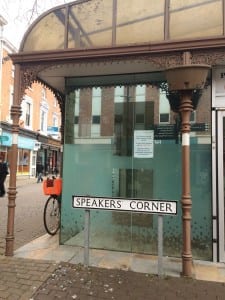
– The first location for our performance installation, Speakers Corner Lincoln High Street, 21st March 2015
The result of our research process was to take an abandoned shop in the centre of the market square in Lincoln’s high street and cover it in QR codes. As we wanted to have a great impact on the high street for our performance it was at this stage that we decided it would be a durational performance (lasting longer than 3 hours).
It was important that the content of our QR codes would each take a number of different forms. Creating over a thousand codes between us we wanted to create a ‘spectacle’ of our performance. Taking care we were not bias towards or against a certain view of the high street we wanted to provide the audience member with an alternative view. Researching the history of the site, I aimed to explore the historical incarnations of retail and the deeper dimensions of the high street that we pass through and ignore every day. We also hoped to liberate the code itself, from its common purpose.
We originally wanted a live documentation on the day involving a table, a printer and a device to research content for the codes. However, after contacting Lincoln Council to confirm with them the event we were planning to execute in the high street, we discovered it would no longer be possible to use the desired location.
We then considered using the side of a major retailer to have a greater impact with our installation but being rejected by the retail owners (M&S), meant that we had to rethink our performance.
By this point, despite a number of stumbling blocks trying to attain permission, our process had been developing similar to the process dictated in “A sardine box of tricks”.
“We stopped seeing the street as a series of snapshots but as an endless movie”(Crab man and Signpost, 2011, 16)
In this text the performers/authors guide the reader through their performance process of researching and performing in a city landscape. Most importantly their process of exploring the site inspired us to follow in their footsteps and “become part of the street’s regular life”, (Crabman and signpost, 2011, 16)
A tactic they used was to “wear something that sets you apart and allows others to have permission to approach you” (Crabman and signpost, 2011, 16), encouraging people to share their stories of the street with you. We discussed the idea of wearing t-shirts to create a ‘uniformed’ impact on the street and this remained a key element of our performance throughout the process.
As well as this “a sardine street box of tricks” gave us the fundamental idea of ‘layers’. “Imagine you are archaeologists of the meanings of your street, then your walkings are excavations” (Crab man and signpost, 2011, 32). This inspired us to view our codes as vehicles on to a different level; uncovering the layers of the high street and revealing them to the audience by layering them in QR codes.
Whilst researching, I stumbled across a link to the website of Blind Ditch projects who “bring together varied voices from the communities we work with, to create unexpected arts and performance events in everyday spaces.” (Blind Ditch, 2013)
I was inspired by their work “This City’s Centre” because their focus on performing a different view of the city centre was similar to our aims. But more importantly I was inspired by their method of live streaming and method of encouraging the public to upload their own elements of performance directly on to their gallery. Taking photos of their view of the city from their windows offers anonymous and always different views of the same space, making me reflect back on the idea of revealing ‘layers’ of the high street.
“By hearing the voices of your neighbours, of people who have walked the same stretch of pavement over and again, just like you, and having their ideas, opinions and thoughts flow into your ears as you contemplate the exact same view that inspired those thoughts, you just might – as I did – feel increasingly connected to the people around you.” (Exeter Insider, 2013)
A number of videos were available on their website that enabled me to view their work further. Although the link would not allow me to import the video to this blog as it has been made private, I am able to produce the link to the webpage in which readers can view the video of Blind Ditch’s performance piece ‘Here and Now’ (Blind Ditch, 2013). http://www.thiscityscentre.net/performance/
From this, we felt it necessary that we create a performance blog in which everything that was coded was to be posted on in order to give the performance another layer. The audience would also be given the link to this blog on the day, thus inviting them to engage with our piece at a later time and in a different format.
http://questioningretail.blogs.lincoln.ac.uk/
Evaluation:
The result of our process was a success. Although our original idea took the form of an installation, the importance of conversation as a method of disruption and the questioning of retail through pervasive media, led us to produce a 6 hour long performance in Lincoln high street. On reflection, it was unfortunate that the weather dampened the materials we had used for our performance. However, our method of inviting the audience to start a dialogue with us continued to have a great impact despite the weather.
If we were to develop the piece I would aim to review two possible ideas that arose during our process. The first development would be a heavier focus on the disruptive conversation, encouraging the audience to have full engagement and participation in the performance, by starting a dialogue with them. For example, sharing a blog post alongside the actors, after creating their own QR code, that revealed a piece of their personal history with the site. This would however need technology live on the day for audience members to use and would logistically have to be considered carefully. The second improvement would be to gain permission for a performance installation in the high street; a visual spectacle of disruption.
In my opinion, the aims of the performance were successfully met. We were able to physically disrupt the high street, questioning the consumerist culture through using social interaction where “humans would interact together as people not mediated by commodities” (libcom.org, 2006). As well as this we were not only able to liberate the audience from their pre-conceived assumptions around Lincoln’s retail environment, but we were also able to question their participation in contemporary consumerist culture through the use of pervasive media.
3283
Works Cited:
Best, S, Kellner, D (1999) Debord and the Postmodern Turn: New Stages of the Spectacle. [online] Available from: http://pages.gseis.ucla.edu/faculty/kellner/Illumina%20Folder/kell17.htm [Accessed on 1st May 2015]
Blind Ditch (2013) This City’s Centre: Here and Now. [performance] Exeter: Blind Ditch Projects. 17th-21st September
Blundell-Jones, C (2011) The Crow that didn’t know, installation. Claire Blundell Jones. [online] available from: http://www.claireblundelljones.co.uk/archipelago.html [Accessed on 10th March 2015]
Blundell Jones, C. (2010) Walking, the Western and the tumbleweed. Visual Studies. 25 (1) 87-88
Lavery, C. (2005) Teaching Performance Studies: 25 instructions for performance in cities. Studies in Theatre and Performance. 25 (3) 229-236
Crab man and Signpost. (2011) A Sardine Street Box of Tricks. Exeter: Blurb. 30-32
Crow, P (2015) Lincoln School of Fine and Performing Arts: Site Specific 2015. Flickr. [Online] Available from: https://www.flickr.com/photos/61839232@N02/17238281760/in/album-72157652062387628/ [Accessed on 11th May 2015]
Debord, G. (1967) Society of the Spectacle. Transcription/HTML by Greg Adargo. [online] Available from: https://www.marxists.org/reference/archive/debord/society.htm [Accessed on 6th May 2015]
Exeter Insider (2013) This City’s Centre 2: Linger. Exeter Insider. [online] Available from: http://www.exeterinsider.co.uk/2013/08/this-citys-centre-2-linger.html. [Accessed on 15th March 2015]
Gorman, S. (2003) Wandering and Wondering. Performance Research. 8 (1) 167-178
Lavery, C. (2005) Teaching Performance Studies: 25 instructions for performance in cities. Studies in Theatre and Performance. 25 (3) 229-236
Lyotard, J.F. (1984) The Postmodern Condition: A report on knowledge. Translated from French by Geoff Bennington and Brian Massumi. UK: Manchester University Press.
libcom.org (2006) Situationists – an introduction [online] Available from: https://libcom.org/thought/situationists-an-introduction. [Accessed on 1st May 2015]
Macmillan Dictionary (2009) QR Codes. [online] Available from: http://www.macmillandictionary.com/dictionary/british/qr-code [Accessed on 8th March 2015]
Pervasive Media Studio. (2015) What is Pervasive Media? [online] Bristol: Pervasive Media Studio. Available from http://www.pmstudio.co.uk/pmstudio/what-pervasive-media[Accessed 29th January 2015]
Pearson, M. (2010) Site-Specific Performance. Basingstoke: Palgrave Macmillan.
Pinckbeck, M. (2012) Sit With Me for a Moment and Remember. [Performance] Michael Pinckbeck (dir.)
Questioning Retail (2015) Lincoln, 4th May 2015. Instagram. [Online] Available from: https://instagram.com/p/2QmSwXpD3n/?taken-by=questioning_retail [Accessed on 12th May 2015]
Sandford, M R. (ed.) (1995) Happenings and Other Acts. London: Routledge.
Tapper, J. (2014) Pervasive Games: Representations of Existential In-Between-Ness. Themes in Theatre, 8, 143-161.
Watershed (2015) Pervasive Media Studio: What is Pervasive Media? [online] Bristol: Watershed. Available from http://www.watershed.co.uk/pmstudio/what-pervasive-media [Accessed on 26/01/2015]
Walker, H.J. and Thorpe, C. (2015) I Wish I Was Lonely [performance] Lincoln: Lincoln Performing Arts Centre, 11 February.
Word Press Blog (2015) Questioning Retail. [online blog] Lincoln: Word Press. Available from: http://questioningretail.blogs.lincoln.ac.uk/ [Accessed on 13th May 2015]
